The Pennsylvania Railroad, legal name The Pennsylvania Railroad Company, also known as the "Pennsy", was an American Class I railroad that was established in 1846 and headquartered in Philadelphia, Pennsylvania. At its peak in 1882, the Pennsylvania Railroad was the largest railroad, the largest transportation enterprise, and the largest corporation in the world, on par with the London & North Western Railway.

The American Locomotive Company was an American manufacturer that operated from 1901 to 1969, initially specializing in the production of locomotives but later diversifying and fabricating at various times diesel generators, automobiles, steel, tanks, munitions, oil-production equipment, as well as heat exchangers for nuclear power plants.

A diesel locomotive is a type of railway locomotive in which the power source is a diesel engine. Several types of diesel locomotives have been developed, differing mainly in the means by which mechanical power is conveyed to the driving wheels. The most common are diesel–electric locomotives and diesel–hydraulic.

The Baldwin Locomotive Works (BLW) was an American manufacturer of railway locomotives from 1825 to 1951. Originally located in Philadelphia, Pennsylvania, it moved to nearby Eddystone in the early 20th century. The company was for decades the world's largest producer of steam locomotives, but struggled to compete when demand switched to diesel locomotives. Baldwin produced the last of its 70,000-plus locomotives in 1951, before merging with the Lima-Hamilton Corporation on September 11, 1951, to form the Baldwin-Lima-Hamilton Corporation.
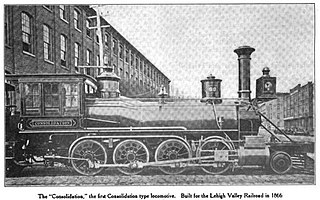
Under the Whyte notation for the classification of steam locomotives, 2-8-0 represents the wheel arrangement of two leading wheels on one axle, usually in a leading truck, eight powered and coupled driving wheels on four axles, and no trailing wheels. In the United States and elsewhere, this wheel arrangement is commonly known as a Consolidation, after the Lehigh and Mahanoy Railroad’s Consolidation, the name of the first 2-8-0.

The Little Joe is a type of railroad electric locomotive built by General Electric. The locomotives had twelve axles, eight of them powered, in a 2-D+D-2 arrangement. They were originally intended to be exported to the Soviet Union and designed to operate on Soviet Railways (SZhD) 3,300-volt DC overhead line system. They were never exported to the Soviet Union due to rising political tensions. Only 20 were built, with 15 sold to domestic operators and five exported to Brazil.

The Pennsylvania Railroad (PRR) class T1 duplex-drive 4-4-4-4 steam locomotives, introduced in 1942 with two prototypes and later in 1945-1946 with 50 production examples, were the last steam locomotives built for the PRR and arguably its most controversial. They were ambitious, technologically sophisticated, powerful, fast and distinctively streamlined by Raymond Loewy. However, they were also prone to wheelslip both when starting and at speed, in addition to being complicated to maintain and expensive to run. The PRR decided in 1948 to place diesel locomotives on all express passenger trains, leaving unanswered questions as to whether the T1's flaws were solvable, especially taking into account that the two prototypes did not have the problems inherent to the production units.

The EMD E8 is a 2,250-horsepower (1,678 kW), A1A-A1A passenger-train locomotive built by General Motors' Electro-Motive Division (EMD) of La Grange, Illinois. A total of 450 cab versions, or E8As, were built from August 1949 to January 1954, 447 for the U.S. and 3 for Canada. 46 E8Bs were built from December 1949 to January 1954, all for the U.S. The 2,250 hp came from two 12 cylinder model 567B engines, each driving a generator to power the two traction motors on one truck. The E8 was the ninth model in the line of passenger diesels of similar design known as EMD E-units. Starting in September 1953, a total of 21 E8As were built which used either the 567BC or 567C engines.

The Pennsylvania Railroad's S2 class was a steam turbine locomotive designed and built in a collaborative effort by Baldwin Locomotive Works and Westinghouse Electric & Manufacturing Company, as an attempt to prolong the dominance of the steam locomotive by adapting technology that had been widely accepted in the marine industry. One was built, #6200, delivered in September 1944. The S2 was the sole example of the 6-8-6 wheel arrangement in the Whyte notation, with a six-wheel leading truck keeping the locomotive stable at speed, eight powered and coupled driving wheels, and a six-wheel trailing truck supporting the large firebox. The S2 used a direct-drive steam turbine provided by the Westinghouse Electric & Manufacturing Company, geared to the center pair of axles with the outer two axles connected by side rods; the fixed gear ratio was 18.5:1. Such design was to prevent energy loss and S2 achieved a mechanical efficiency of 97% which means only 3% of steam energy was lost within the propulsion equipment. The disadvantage of a direct-drive steam turbine was that the turbine could not operate at optimal speeds over the locomotive's entire speed range. The S2 was the largest, heaviest and fastest direct-drive turbine locomotive design ever built.

EMD E-units were a line of passenger train streamliner diesel locomotives built by the General Motors Electro-Motive Division (EMD) and its predecessor the Electro-Motive Corporation (EMC). Final assembly for all E-units was in La Grange, Illinois. Production ran from May 1937, to December, 1963. The name E-units refers to the model numbers given to each successive type, which all began with E. The E originally stood for eighteen hundred horsepower, the power of the earliest model, but the letter was kept for later models of higher power.
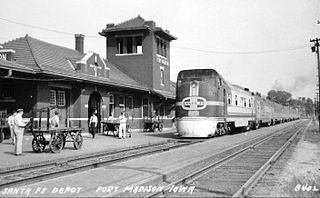
Electro-Motive Corporation produced five 1800 hp B-B experimental passenger train-hauling diesel locomotives in 1935; two company-owned demonstrators, #511 and #512, the Baltimore and Ohio Railroad's #50, and two units for the Atchison, Topeka and Santa Fe Railway, Diesel Locomotive #1. The twin engine power unit layout and multiple unit control systems developed with the B-B locomotives were soon adopted for other locomotives such as the Burlington Route's Zephyr locomotives built by the Budd Company in 1936 and EMC's own EMD E-units introduced in 1937. The B-B locomotives worked as proof-of-concept demonstrators for diesel power with the service loads of full size trains, breaking out of its niche powering the smaller custom Streamliners.

The Baldwin DR-4-4-1500 was a 1,500-horsepower (1,100 kW) cab unit-type diesel locomotive built for freight service by the Baldwin Locomotive Works between November 1947 and June 1950. It was produced in two different body types, nicknamed the "Babyface" and "Sharknose" styles by railfans, though Baldwin used the same model number for both. 22 "Babyface" cab-equipped A units were built, along with 11 cabless booster B units; 36 "Sharknose" A units and 36 B units were constructed, making a total for all models of 105 locomotives built.

The ALCO PA was a family of A1A-A1A diesel locomotives built to haul passenger trains. The locomotives were built in Schenectady, New York, in the United States, by a partnership of the American Locomotive Company (ALCO) and General Electric (GE) between June, 1946 and December, 1953. Designed by General Electric's Ray Patten, they were of a cab unit design; both cab-equipped lead A unit PA and cabless booster B unit PB models were built. While externally the PB models were slightly shorter than the PA model, they shared many of the same characteristics, both aesthetically and mechanically. However, they were not as reliable as EMD E-units.
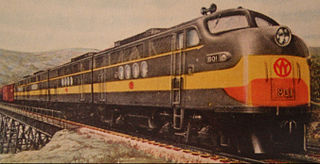
The New York, Ontario and Western Railway, commonly known as the O&W or NYO&W, was a regional railroad founded in 1868. The last train ran from Norwich, New York, to Middletown, New York, in 1957, after which it was ordered liquidated by a U.S. bankruptcy judge. It was the first Class I U.S. railroad to be abandoned in its entirety.

Dieselisation is the process of equipping vehicles with a diesel engine or diesel engines.
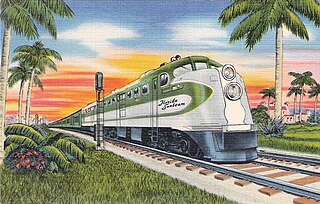
The ALCO DL-109 was one of six models of A1A-A1A diesel locomotives built to haul passenger trains by the American Locomotive Company (ALCO) between December, 1939 and April, 1945. They were of a cab unit design, and both cab-equipped lead A units DL-103b, DL-105, DL-107, DL-109 and cabless booster B units DL-108, DL-110 models were built. The units were styled by noted industrial designer Otto Kuhler, who incorporated into his characteristic cab the trademark three-piece windshield design. A total of 74 cab units and four cabless booster units were built.

Baldwin Locomotive Works produced several different Baldwin DR-6 models of 6-axle passenger train-hauling diesel locomotives between 1945 and 1948. The series comprised eight individual versions, all of which sold only in small numbers; across all versions, only 39 locomotives were produced. Each version was produced only for a single railroad. Many shared the same Baldwin model number, DR-6-4-2000, even though they were rather different; this was because the Baldwin model only encoded the total axles (6), the driven axles (4) and the power output. The single exception was the single unit produced for the Chicago and North Western Railway, which had a single 1,000 hp (750 kW) engine and was model number DR-6-2-1000. In the AAR wheel arrangement scheme of classification, these locomotives were of A1A-A1A and A1A-3 arrangements, respectively.
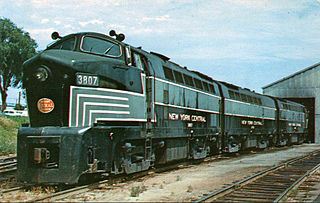
The BLH RF-16 is a 1,625-horsepower (1,212 kW) cab unit-type diesel locomotive built for freight service by the Baldwin-Lima-Hamilton Corporation between 1950 and 1953. All RF-16s were configured with a B-B wheel arrangement and ran on two AAR Type B two-axle road trucks, with all axles powered. A total of 109 cab-equipped A units were built, along with 51 cabless booster B units, for a total of 160 locomotives built. As was the case with most passenger locomotives of its day, the RF-16s came equipped with a retractable, nose-mounted drop coupler pilot. Unlike competing units from EMD and Alco, the RF-16 used an air-powered throttle, meaning that it could not be run in MU operation with EMD or Alco diesels without special MU equipment.
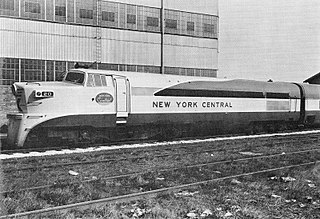
The RP-210 was a streamlined 1,000 hp (750 kW) locomotive built in 1956 by Baldwin-Lima-Hamilton, specifically to operate with the experimental, all-aluminum Train-X coaches that were built by the Pullman-Standard Car Manufacturing Company. The model represented Baldwin's attempted entry into the lightweight passenger locomotive market, but only three of the low-slung diesel-hydraulic units were produced. The first RP-210 was built for the New York Central Railroad to power their Ohio Xplorer train between Cleveland, Columbus, and Cincinnati, and a pair was purchased by the New York, New Haven and Hartford Railroad to double-end their Dan'l Webster, running between New York City and Boston.
Delaware and Hudson 1205 and 1216 are two Baldwin RF-16 locomotives originally built for the New York Central Railroad in 1951 and 1952. They are the last two surviving examples of the Baldwin RF-16.


















